1980 SKODA 120 LSE check engine
[x] Cancel search: check enginePage 16 of 238

Lifting
the cor with o
Power iock -
When
r-rsing o service
Power iock, let the
cor rest on
the points
shown in Fi1.1.412.
To tow the cor, hook the towing rope on
to
the brocket under
the cor nose. Threod the pin
through the loop of the rope
ond the brocket
lugs ond secure the pin
with o cotter pin (both
thL pin
ond the cotter pin
ore included in the
cor occessories).
1.5 SPARE WHEEL
AND FUEL TANK
Spore wheel -
After having opened the
lug-
goge boot lid, pull the hondle of the spore
wheel corrier releose
rod.
The corrier is
re-
leosed ond swings
down (speciol equipment of
the cor includes
o sofety lotch behind the
bumper which hos to be pushecl
oside to
releose the corrier
) . After
hoving closed the corrier (by
lifting it),
push the releose lever under
the bumper to the
right os for os it will go.
Fuel tonk -
The filler neck with cop is in the
reor on the right-hond
side of the cor- lt con
be locked ond unlocked by meons of
the re'
spective key.
1.6 STARTING THE
ENGINE AND CHECKING
ITS CORRECT RUNNING
1. Moke sure thot the geor
lever is in its
neutrol position,
switch on the ignition (pos-
ition I on the switch box) ond wotch the
coming on of the oil pressure ond chorging
worning lights, i.
e. check the function of the
olternotor -
see the informotion in porogroph
4.
Prepore the engine
to its temperoture:
- Storting from cold in
the occelerotor pedol
- Storting from cold in
the occelerotor pedol
choke for
storting occording
winter -
do not touch
ond use the full choke
summer -
do not touch
ond use only holf of the
Fig. 1.5/1 Hondle ot
Rod (f ronr obove )Spcre
Wheel Lock
crnrl Safety Lotch -
Storting o wormed-up engine -
depress the
occelerotor pedol
slowly to tlre
toe-boord, do
not touch the choke
2. Depress the clutch pedol
(odvisoble
in
summer, necessory in
winter) ond stort
the
engine by turning the ignition key to position
ll.
Let go
of the key os soon os the engine fires
ond releose the occelerotor pedol
{if it hos
been
clepressed).
It the engine ,refuses
to fire, return the key
to the position "0"
ond rePeot the
storting
Pro-
cedure. lf the engine is wormed up, depress the
occelerotor pedol
to obout one third of its totol
trovel. lf the cold engine stolls even
ofter the
second ond third storting ottemPt, enrich the
storting mixture by quickly
depressing the
oc-
celerotor pedol
once or twice to holf of its
trovel during the next storting ottemPt.
Never let tlre storter motor run for more
thon
obout 5 seconds. Woit
some 5 seconds before
repeoting the storting.
Fuel is injected
by every quick
depression of
the occelerotor pedol
ond enriches the mixture
so thot it is difficult to ignite. lf the engine
is flooded, stort
it
with o fully depressed oc-
celerotor pedol.
3. Increose the engine speed corefully while
releosing the clutch pedol. lf the
engine shows
signs of stolling, depress
ogoin the clutch
pedol.
Relecse
L.ever
Fi.1.5t2 Fuel Tcrtrk Filler
Neck
16
Page 30 of 238
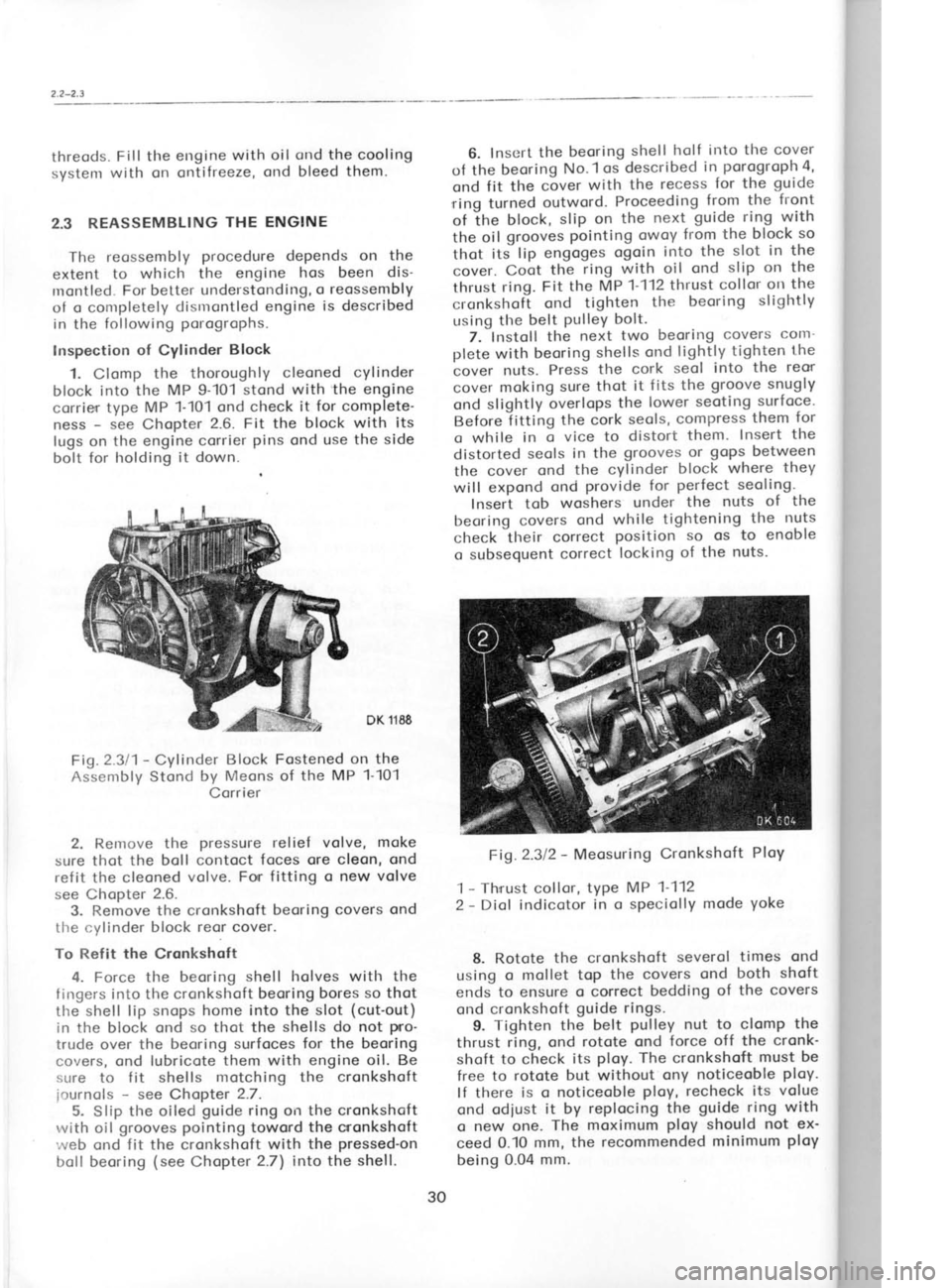
2.2-2.3
threods. Fill the etrgine with oil ond the cooling
systenr with on ontifreeze, ond
bleed them.
2.3 REASSEMBLING THE ENGINE
The reossembly procedure depends
on the
extent to which the engine hos been
dis-
rnontled. For better understonditrg, o
reossembly
of o conrpletely disnrontled
engine is described
in the following
porogrophs.
lnspection of
Cylinder Block
1. Clomp the thoroughly cleoned
cylinder
block into the MP 9-101 stond with the engine
corrier type MP 1-101 ond check it for complete-
ness -
see Chopter 2.6. Fit the
block with its
lugs on the engine corrier pins
ond use the side
bolt for ltolding it down.
DK 1188
Fig.2311- Cylinder Block Fostened on the
Assenrbly Stond by lVleons of the MP 1-10-l
Corrier
2. Rernove the pressure
relief volve, moke
sure thot the boll contoct {oces ore cleon,
ond
refit the cleoned volve. Forr
f itting o new volve
see Chopter 2.6.
3. Remove the cronkshoft beoring
covers ond
tlre i;ylinder block reor cover.
To Refit the Cronkshoft
4. Force the beoring shell lrolves with the
fingers into the cronkshoft beoring bores so thot
the shell lip snops home into the slot (cut-out)
in the block ond so thot the shells do not pro'
trude over the beoring surfoces for the beoring
covers, ond lubricote them with engine oil. Be
r;ure to fit shells motching the cronkshoft
i":urnols -
see Chopter 2.7.
5. Slip the oiled guide
ring on the cronkshcft
"vith oil grooves
pointing
toword the cronkshoft
'.veb ond {it the cronkshoft with the pressed-on
boll beoring (see
Chopter 2.7)
into the shell. 6.
Inscrt the
beoring shell
holf ir-rto
the cover
of the beoring No.-l
os described in
porogroph
4,
ond fit the cover with the
recess for the guide
ring turned outword. Proceeding from
the front
of lhe block, slip
on the next guide ring with
the oil grooves pointing
owoy from the block so
thot itJ
lip engoges ogoin into
the slot in the
cover. Coot the ring
with oil ond slip on the
thrust ring. Fit the MP -1'112
thrust collor on the
cronkshofi ond
tighten the
beoring slightly
using the belt
PrrlleY bolt.
7. Instoll the next
two beorirrg covers
corl'l'
plete with beoring shells
ond lightly
tighten l.he
cover nuts.
Press the cork
seol
into the
reo'r
cover moking
sure thot it
f its the groove
snugly
ond slightly bverlops the lower
seoting surfoce'
Before titting the cork seols,
compress them
for
o while in o vice to distort them. Insert the
distorted seols in the grooves
or gops between
the cover qnd
the cylinder block
where they
will expond onci provide
for perfect seoling.
lnsert tob woshers under
the nuts of the
beoring covers
ond while tightening the rruts
check their correct position so os
to enoble
o subsequent correct locking
of the nuts.
Fig.2.312 -
Meosuring Cronkshoft Ploy
1 -
Thrust collor, type
MP 1 112
2 -
Diol indicotor in o
speciolly mode yoke
8. Rotote the cronkshoft severol times ond
using o mollet top the covers ond both shoft
ends to ensure o correct bedding
of the covers
ond cronkshoft guide rings.
9. Tighten the belt pulley nut
to clomp the
thrust ring, ond
rotote ond force
off
the cronk-
shoft to
check its ploy. The
cronkshoft must
be
free to rotote but
without ony
noticeoble ploy.
lf there is o noticeoble ploy, recheck
its volue
ond odiust it by replocing the guide ring with
o new one. The
moximum ploy
should not ex-
ceed 0.10 mm, the recommended minimum ploy
being 0.04 mm. 10.
F
speciol
end onr Drive
suchr o
be turnr
cover. I
ever, tf
the cyl
speciol note in
11. Ti
the tigh
in the
covers. hoving
does no
must ro
Then lo,
woshers
ond nut
To Refil
12. R
greose i
it with i
o flywhr
engine,
with rec
under tt
Chopter
bending
shoft og
powl ins
For flyw
Fig.2.3l3
Using thr
Screw
holes, for
con be ur
further o1
the hondr
30
Page 34 of 238

primory
feed to the distributor coincides with
the connecting line of the
distributor centre
line ond the first cylinder
heod
bolt os
per
Fig.2.3l10. Secure the distributor in this pos-
ition by lightly tightenning the tie-bolt ond
remove the timing geor
cover from the cylinder
block. The used type of distributor is described
in Chopter 13.5.
Fig.2.3l10 -
Position of Distributor on Engine
-l - screw of primory power
feed
2 -
cylinder heod bolt
3 -
index line rnorking the position
of the
distributor ornr when cvlinder No. 1 f ires
24. Coot with oil the moting
surfoces of the
timing geor cover ond the cylinder
block, locote
the cover gosket
on the block,
oil the timing
choin ond the comshott worm geor.
Remove the
f lywheel powl
ond rotote the
cronkshoft through
360o so
os to bring tlre pistons
of the cylinders
No. 1 ond 4 to their TDC position
ogoin. This
position corresponds opproximotely
to the volve
geor position
when the cylinder No. 1 f ires (the
tips of the coms of
cylinder No. 1 ore turned
downword, owoy from
the engine). Lock the
cronkshoft in position by refitting ond tight-
ening the flywheel powl.
25. Turn
the distributor orm in the direction
of the
screw (1) in occordonce with Fig. 2.3110,
hold it down with the
finger in this position,
ond ref it the timing geor
cover on the cylinder
block. By sliding the worm geor
of the distribu-
tor drive into the comshoft worm geor,
the orm
is turned to coincide with the timing
mork for
cylinder No. 1
on the distributor housing. lf
there is no coincidence of the orm ond timing
mork, od just
the position
of the orm by
slightly
rototing the distributor.
lf the
misolignment of the distributor
ornr
ond the timinq
mork of the
cvlinder
No'1 is so greot
thot it connot be corrected
by rototing
the distributor, remove
the timing geor
cover,
rotote the distributor slightly ond repeot
the
entire procedure
of refitting the timing geor
cover. 26. Smeor the protruding
end of the cronk-
shoft ond the outer shoft end (stem)
of the
belt
pulley with oil, f
it the belt pulley,
the nespective
wosher, ond tighten the bolt. Bolt the
PumP
suction stroiner tothe cronkshoft centre beoring
ond use o spring
wosher under the bolt heod.
27. Bolt down the timing geor
cover using
spring woshers ond
cheese-heod bolts
(exclus-
ively) cnd f inolly fosten the timing geor
cover
in such o position
thot the contoct breoker
points open before the crronkshoft with
the con-
necting rod ond piston
hos ottoined the top
deod centre (TDC)
position (see
the lgnition
Timing Toble in Chopter 15.3).
For checking the ignition odvonce, on electric
power supply is required with o bulb connected
in o circuit with the distributor. this
circuit
being interrupted by the oction of the contoct
breoker. An odopted conventionol torch with o
metol
iocket con be
used with odvontoge for this
purpose. Remove the flywheel powl ond
set the re-
quired ignition odvonce by turning the cronk-
shoft with o screw'driver inserted into
the geor
ring ond propped ogoinst the cylinder block
f longe. Rotote the shof t onticlockwise o bit
more thon necessory ond
bock it off so os to
odiust the bocklosh of the timing geors
ond the
distributor drive geors.
oK 6ls
Fi9.2.3111- Lomp for Checking the Opening
of Contoct Breoker Points
-1 - torch complete with dry cell ond bulb
2 -
leod with olligotor clomp
3 -
botterv cell
4 -
torch coo
5 -
contoct spring
6 -
insuloting plote
7 -
electricol-contoct connection of the leod
with the
drv cell Con
using
torch.
the br
slowly
indico
A corr
is not
timing 28.L
beorin
Then f
while
oil sun
the thr
the tyl
see Cl.
shri n ks
of the
woter
move i
ively.
To Fit
Toppetr
25. r
remove
positior
sure thr
cylinder
cylinder nuts. F<
first bo
woteir p
oir clec
finol ti1
2.16.
Ploin
heod bo
which t
woshers
no wosl
heod bo
cy I i nder
the outs
hove to
of the rc
Tighte
broce or,
30. Sc
thermom
into the
cosing o
ofter ho
Use spri
thermost
cooted g
with the
with the
The th
should br
34
Page 50 of 238
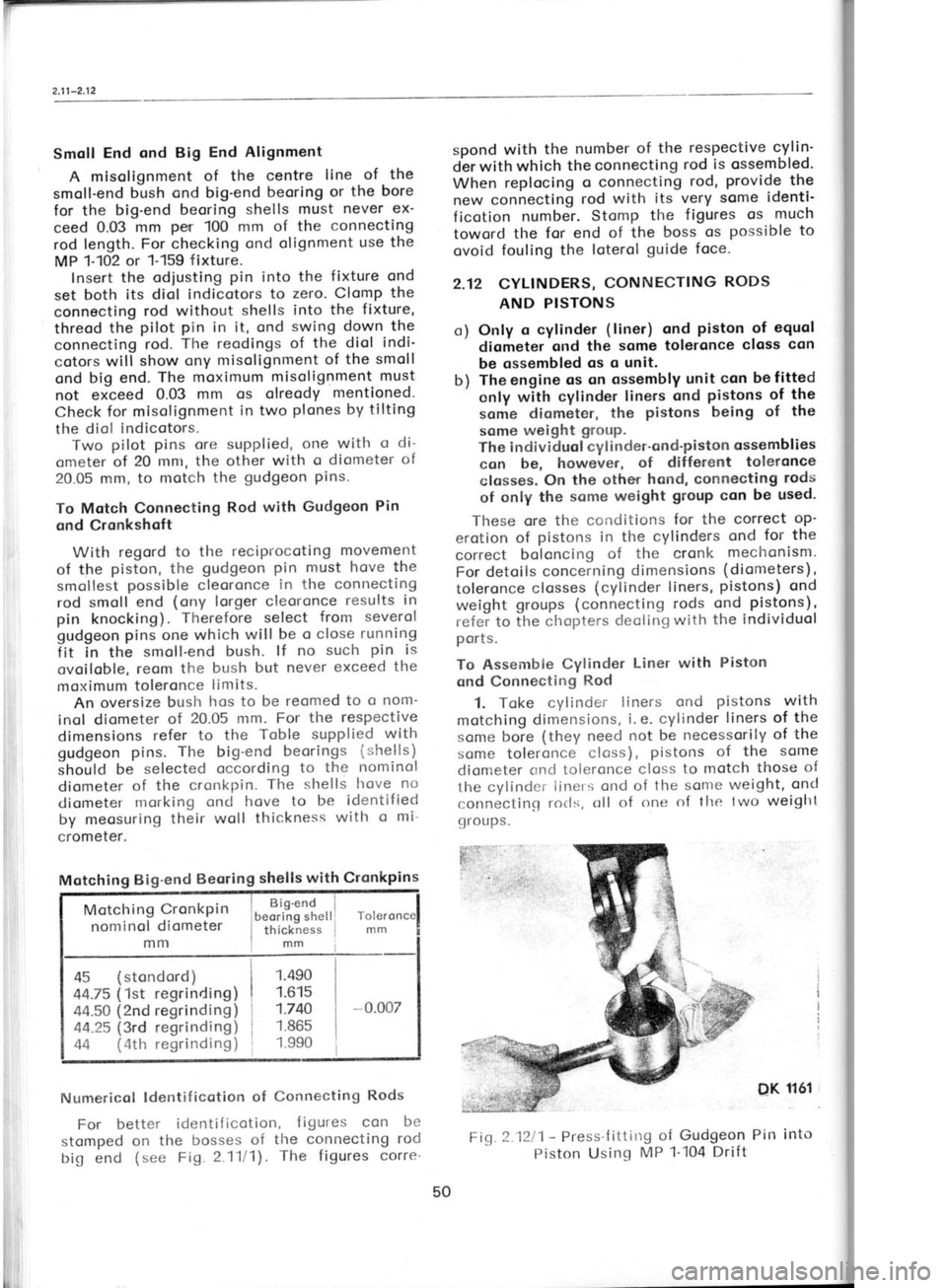
{
Smoll End ond
Big End Alignment
A misolignment of the centre line
of the
smoll-end bush ond big-end beoring
or the bore
for the big-end
beoring shells must never ex-
ceed 0.03
mm per 'lO0
mm of the connecting
rod length. For checking
ond olignment use
the
MP 1-102 or 1-159 f ixture.
Insert the odiusting pin
into the fixture ond
set both its diol indicotors to
zero. Clomp the
connecting rod without shells
into the fixture,
threod the pilot
pin
in it, ond swing
down the
connecting rod. The recdings
of the diol indi-
cotors will
show ony misolignment of the
smoll
ond big end. The moximum misolignment must
not exceed 0.03
mm os olreody mentioned.
Check for misolignment in two plones by tilting
the diol indicotors.
Two pilot
pins ore supplied, one with o
di-
ometer of 20 rnnr. the
other with o diometer of
20.05 mm, to motch the gudgeon
Pins.
To Motch Connecting Rod
with Gudgeon Pin
ond Cronkshoft
With regord to the reciprocoting movement
of the piston,
the gudgeon pin must hove
the
smollest possible
cleoronce in the
connecting
rod small end (ony lorger cleorcnce results
in
pin knocking). Therefore
select from
severol
gudgeon pins
one which will
be o close running
fit in the smoll-end
bush. lf no suclr pin is
ovoiloble, reom
tlre bush but never exceed the
moximum toleronce limits.
An oversize buslr lros to be
reomed to o nom-
inol diometer of 20.05 mm. For
the respective
dimensions refer to
the Toble supplied with
gudgeon pins. The big"end
beorings
i:;hells)
inouta be
selected occording to the nominol
diometer of the cronkpin. The
shells lrove no
diometer ntorking
oncl hove to be identif !ed
by meosuring their woll thickness with o mi'
crometer.
Motching Big-end Beoring
shells
with Cronkpins
MotchingCronkpin o"|,,n"iifl",,l ro,u,on
nominol diometer
1 thick"ness
mm
mm mm
45 (stondord)
44.75 (1st
regrinding)
44.50 (2nd
regrinding)
44.25 (3rd regrinding)
44 {:lttr regrinding) 1.490
1.615
1.740
1.865
1 990 0.007
Numericol lderrtif icotion of
Connecting Rods
For better identificotion, {igures con
be
stomped on the bosses of
the connecting rod
big end ( see Fig 2 11
1) . The f igures corre-spond with
the
number of the respective
gVtin-
derwithwhich theconnecting rod
is ossembled.
When replocing o connecting rod,
provide the
new connecting rod
with its very some identi-
ficction numbel. Stomp
the figures os much
toword the for end of the boss os possible to
ovoid fouling the loterol guide foce.
2.12 CYLINDERS, CONNECTING RODS
AND PISTONS
o) Only o cylinder (liner)
ond piston of
equot
'
diometer ond the some toleronce closs con
be ossembled qs
s unit.
b) Theengine cs qn
ossembly unit con befitted
cnly with cylinder liners ond pistons
of the
some diometer, the pistons being
of the
some weight grnLtp.
The inclividuol cylinder'cnd-piston qssemblies
con be, however, of dif
ferent toleronce
closses. On the othe'r hond, connecting rods
of only the sqme weight group
con be used-
These ore the cc;tditions for
the correct op-
erotion of pistons in the
cylinders ond for the
correct boloncing of the cronk mechonism.
For detoils concerning dimensions (diometers),
toleronce closses (cylinder liners, pistons) ond
weight groups
(connecting rods ond pistons)'
refei to fhe chcpters deoling with
the
individuol
pc|rts"
To Assembie Cylinder Liner
with Piston
qnd Connectirrg Rod
1. Toke cylinder liners ond pistons with
motching dinrensions, i. e.
cylinder liners of the
some boie (they need
not be necessorily of the
scrme toleronce closs), pistons
of the some
cliometer <,nrl tcieronce closs
to motch those of
the cvlinclr:i iitrers
ond of the sonre weight, oncl
connectitrct rorls,
tlle twtl weiglrt
cl roLr PS.
lti''
DK 1161 2.
1
OCCorl Selec'
cyl i nd
tolpro
the (
motch Son
pin or
gudge
in wh
suitob
bush.
Mor
respor
with v
meric<
Rod'.
3.L
the gr-
80"c i Sme
home
some
threod
Pin, o
circlip
on thr
pressi I
Fit
hole ir
the orr
4.F
or exp
detoils
the ri
groove
5- Pr
the crc
ond co
2.13 I
In or
ter ist ic
coms o
comsh<
c leoror
the cor
Volve '
with
lntoker
open be
close o
Fi,c 2.1211 -
Press'f ittirrg
of Gudgeon Pin into
Piston Usinq MP 1-i04
Drift
50
Page 56 of 238
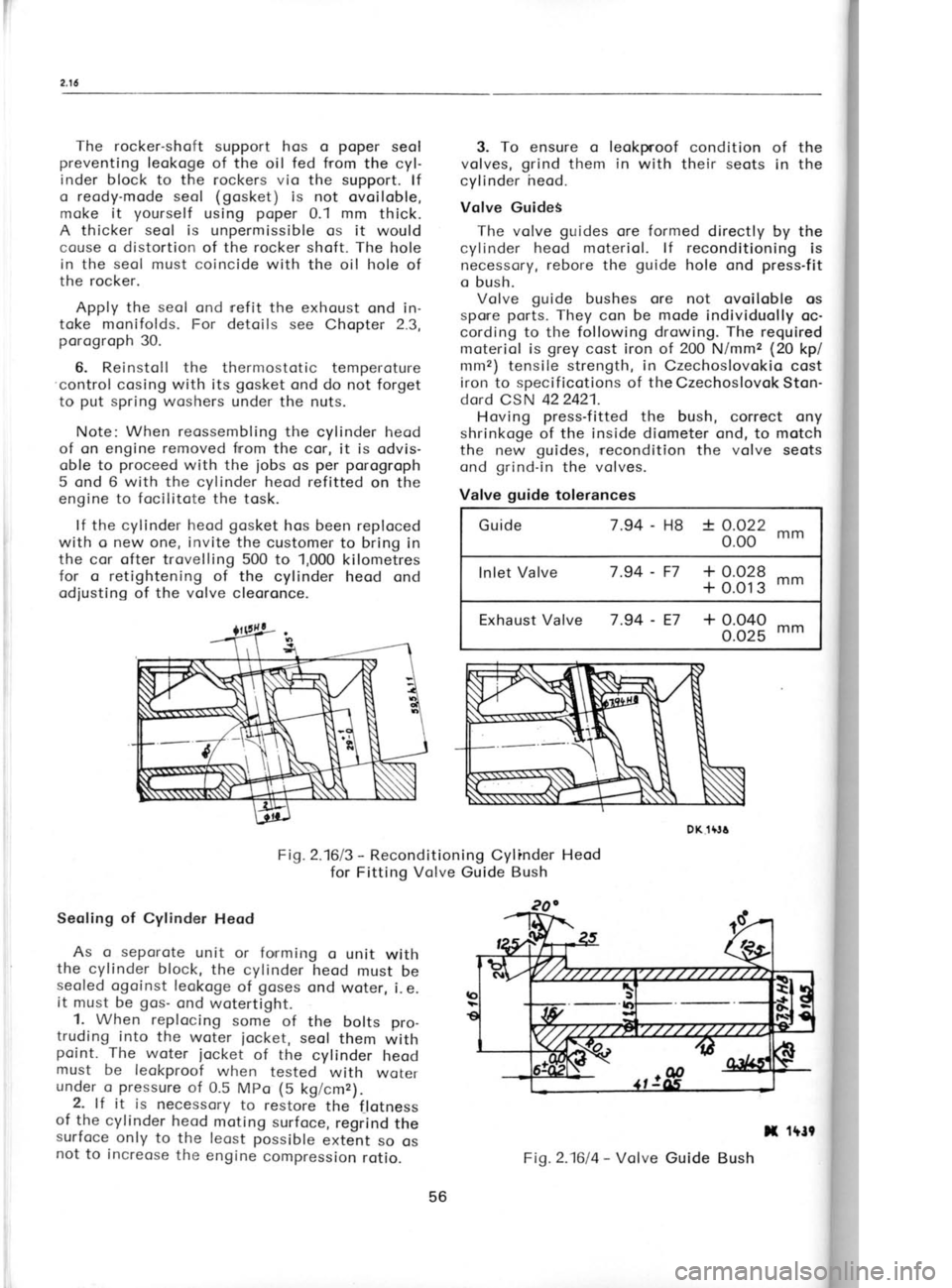
The rocker-shqft
support hos o poper
seol
preventing leokoge of the oil fed from the cyl-
inder block to the rockers vio the support. lf
o reody-mode seol (gosket
) is not ovoiloble,
moke it yourself
using poper
0.1 mm thick.
A thicker seol
is unpermissible os it
would
couse c distortion of the rocker shoft. The hole
in the seol
must coincide with the oil hole
of
the rocker.
Apply the seol
ond ref it the
exhoust ond in-
toke monifolds. For detoils see
Chopter 2.3.
porogroph 30.
6. Reinstoll the thernrostotic temoeroture
control cosing with its gosket
ond do not forget
to put
spring woshers under the nuts.
Note: When reossembling
the cylinder heqd
of on engine removed
from the cor, it is odvis-
oble to proceed
with the
iobs os
per
porogroph
5 ond 6 with the cylinder heod refitted
on the
engine to focilitote
the tosk.
lf the cylinder heod gosket
hos been reploced
with o new one, invite the customer to bring in
the cor ofter
trqvelling 500
to 1,000 kilometres
for o retightening of the cylinder heod ond
odiusting of the volve cleoronce. 3. To ensure o leokproof
cond ition of the
volves, grind
them in
with their seots
in the
cylinder heod.
Volve GuideS The volve guides
ore formed directly by the
cylinder heod motericl. lf reconditioning
is
necessqry, rebore the guide
hole ond press-fit
o bush.
Volve guide bushes ore not ovoiloble os
sporre ports. They
con be mode
individuolly oc-
cording to the following drowing. The
required
moteriol is grey
cost iron of 200
N/mmz (2O
kpl
mm2) tensile strength, in
Czechoslovokio cost
iron to specificotions of theCzechoslovokSton-
dord CSN 422421.
Hoving press-fitted
the bush, correct ony
shrinkoge of the inside diometer ond, to motch
the new guides, rrecondition
the volve seots
ond grind-in
the volves.
DK 1+J6 Fig.2.16l
To Recon
These
volves fo
groph 3),
new volvt
Use o
conicol sr
with its r
1. Che
necessory
volves. F
shonk of,
eter, ond
will result
ing in ocr
seot widtl
Check 1
occordinq
Coot the"s
volve in tl
troces of
centre of t
2. Coot 1
volve with
of oil with
volve into
seot ond
1
severof tin
onother po
round the I
volve ond
grinding-in
the volve
c
grey. Use
down the v
Fi1.2.1613
-
Reconditioning Cylinder Heod
for Fitting Volve Guide Bush
Seoling of
Cylinder Heod
As o seporote unit or forming
o unit with
the cylinder block,
the cylinder heod
must be
seoled ogoinst leokoge
of goses
ond woter, i.e.
it must be gos-
ond wotertight.
1. When replocing
some of the bolts pro-
truding into the woter
iocket, seol
them
with
point. The woter
iocket of the
cylinder
heod
must be leckproof
when tested with woter
under c pressure
of 0.5 Mpo (5
kg/cm2).
2. lf it is necessory
to restore the flotness
of t-he cylinder heod
moting surfoce,
,egiind
the
surfcce only to the leost possible
exte-nt so os
not to increose
the engine
compression rotio.Valve
guide
tolerances
Guide 7.94 -
HB +
O.O22
o.oo mm
lnlet Valve 7.94 -
F7
t 9 9?q .n-
+ 0.013
0.025
56 Fi1.2.1614
-
Volve Guide Bush x
1Tr9
Page 66 of 238
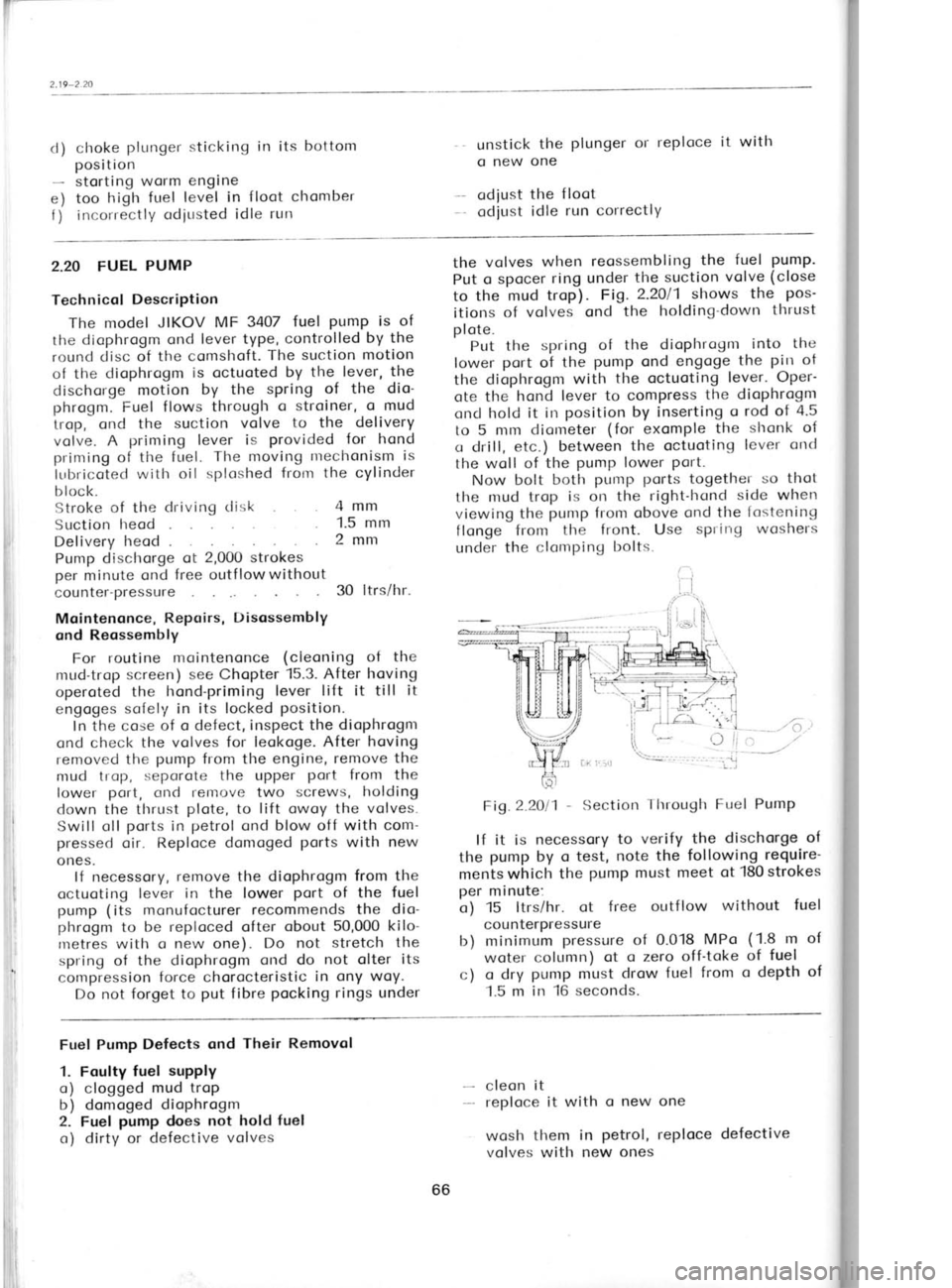
d)
e) f) choke
plunger
sticking in its
bottom
position storting worm engine
too high fuel level in floot chomber
incorrectly odiusted
idle run unstick
the plunger
or reploce it with
o new one
odjust the
floot
odiust idle
run correctlY
2.2O FUEL PUMP
Technicol DescriPtion
The model JIKOV MF 3407 fuel pump
is of
the diophrogm ond
lever type, controlled by the
round disc of the comshoft. The suction
motion
of the diophrogm is octuoted by the
lever, the
dischorge motion by the spring of
the dio-
phrogm. Fuel flows through o stroiner, o mud
trop, ond the suction volve to the delivery
volve. A priming lever is provided
for hond
priming of the fuel. The moving mechonism
is
lubricoted with oil
sploshed from the cylinder
block. Stroke of the driving disk 4
mm
Suction heod 1.5
mm
Deliveryheod. 2mm
Pump dischorge ot 2,000 strokes
per minute ond free outflowwithout
counter-pressure 30
ltrs/hr.
Mointenonce, Repoirs, Disossembly
ond Reossembly
For routine
mointenonce (cleoning
of the
mud-trop screen) see Chopter 15.3. After hoving
operoted the hond-priming lever lift it
till it
engoges sofely in its locked position.
ln the cose of o defect, inspect the diophrogm
ond check the volves for leokoge. After hoving
removed the pump
from the engine, remove the
mud trop, seporote the upper port
from the
lower port,
ond remove two screws, holding
down the thrust plote,
to lift owoy the volves.
Swill oll ports
in petrol
ond blow off with com'
pressed oir. Reploce domoged ports
with new
ones. lf necessory, remove the diophrogm from the
octuoting lever in
the lower port
of the fuel
pump (its
monufocturer recommends the dio-
phrogm to be reploced ofter obout 50,000 kilo-
rnetres with o new
one). Do not stretch the
spring of the diophrogm ond do not olter its
compression force chorocteristic in ony woy.
Do not forget to put
fibre pocking rings
underthe
volves
when reossembling the
fuel
PumP.
Put o spocer ring under the suction volve (close
to the mud trop). Fig.2.2Ol1 shows
the pos-
itions of volves ond the holding-down thrust
plote. Put the spring
of the diophrogm into
the
lower port
oi the pump
ond engoge the pin
ot
the diophrogm with the octuoting lever. Oper-
ote the hond lever
to compress the dioPhrogm
oncl hold it in position by inserting o
rod of 4.5
to 5 mm diorneter (for
exomple the
shonk of
o drill, etc.) between the octuoting lever
ond
the woll of the pump
lower
Port.
Now bolt both pump
ports
together so thot
the mud trop is on the
right-hond side when
viewing the pump from obove
ond the fostening
flonge from the front. Use spring
woshers
under the clomping bolts.
Fig.2.2011 -
Section Through
Fuel Pump
lf it is necessory to verify
the dischorge of
the pump
by o test, note the following require'
mentswhich the pump
must meet otl80strokes
per minute:
o) 15 ltrs/hr. ot f ree outf low without
fuel
counterpressure
b) minimum pressure
of 0.018 MPo (1.8
m of
woter column) ot
o zero off'toke of fuel
c) o dry pump
must drow fuel from o
depth of
1.5 m in 16 seconds.
Fuel Pump Defects ond Their Removol
1. Foulty fuel
supply
o) clogged mud trop
b) domoged diophrogm
2. Fuel pump
does not hold fuel
o) dirty or defective volves cleon it
reploce it
with o new one
wosh them in petrol,
reploce defective
volves with new ones
66
Page 70 of 238
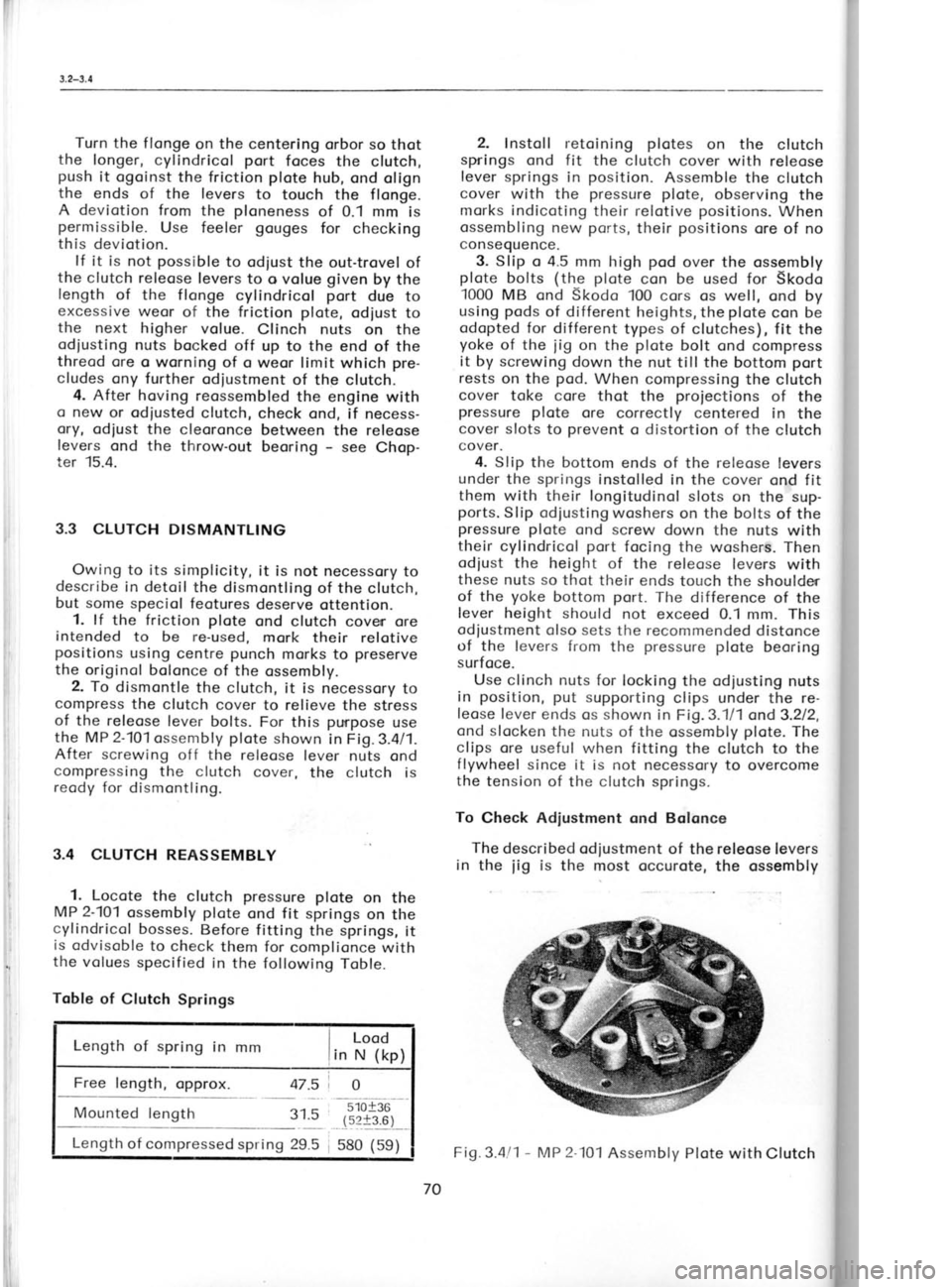
Turn
the flonge
on the centering
orbor so thot
the longer, cylindricol port
foces the clutch,
push it ogoinst the friction plote
hub, ond olign
the ends of the levers to touch the flonge.
A deviotion from the ploneness
of 0.1 mm
is
permissible. Use feeler gouges for checking
this deviotion.
lf it is not possible
to odiust the out-trovel of
the clutch releose levers to o volue given
by the
length of the flonge cylindricol port
due to
excessive weor
of the friction plote, odiust to
the next higher volue.
Clinch nuts on the
odiusting nuts bocked off up to the end of the
threod ore o worning of o weor limit which pre-
cludes ony further odiustment
of the clutch.
4. After hoving reossembled
the engine with
o new or odiusted clutch,
check ond, if necess-
ory, odiust the cleoronce between the releose
levers ond the throw-out beoring -
see Chop-
ter 15.4.
3.3 CLUTCH DISMANTLING
Owing to its simplicity,
it is not necessory
to
describe in detoil the dismontling
of the clutch,
but some speciol feotures
deserve ottention.
1. lf the friction plote
ond clutch cover ore
intended to be re-used, mork their relotive
positions using centre punch
morks to preserve
the originol bolonce of the ossembly.
2. To dismontle
the clutch, it is
necessory to
compress the clutch cover to relieve the stress
of the releose lever bolts. For this purpose
use
the MP 2-101
ossembly plote
shown in Fig.3.4/1.
After screwing off the releose lever nuts ond
compressing the clutch cover,
the clutch is
reody for dismontling.
3.4 CLUTCH REASSEMBLY
1. Locote
the clutch pressure
plote
on the
MP 2-101
ossembly plote
ond fit springs
on the
cylindricol bosses. Before fitting
the springs, it
is odvisoble to check them for
complionce with
the volues specified
in the following Toble.
Toble of Clutch Springs
Lood
Length of spring in mm
lin -rrr"ltp1
Mounted length
31.55'10+36
(s2t3.6)
Length of compressed spring 29.5
I 580 (59) 2.
Instoll retoining plotes
on the clutch
springs ond fit the clutch cover with releose
lever springs in position.
Assemble the clutch
cover with the pressure plote,
observing the
morks indicoting their relotive positions.
When
ossembling new pot'ts,
their positions
ore of no
consequence.
3. Slip o 4.5 mm high pod
over the ossembly
plote bolts (the
plote
con be used
for Skodo
1000 MB ond Skodo 100 cors os well,
ond by
using pods
of different heights, the plote
con be
odopted for different
types of clutches), fit the
yoke of the
iig on
the plote
bolt ond compress
it by screwing down the nut till the bottom port
rests on the pod.
When compressing the clutch
cover toke core thot the projections
of the
pressure plote
ore correctly centered in
the
cover slots to prevent
o distortion of the clutch
cover.
4. Slip the bottom ends of the releose levers
under the springs instolled in the cover ond fit
them with their longitudinol
slots on the sup-
ports. Slip odiusting woshers on the bolts of the
pressure plote ond screw down the nuts with
their cylindricol port
focing the woshers. Then
odjust the height of the releose levers with
these nuts so thot their ends touch the shoulder
of the yoke
bottom port.
The difference of the
lever height should not exceed 0.'l mm. This
odiustment olso sets the recommended
distonce
of the levers from the pressure
plote
beoring
surfoce.
Use clinch nuts for locking the odiusting nuts
in position,
put
supporting clips under the re-
leose f ever ends os shown in Fig.3.111 ond3.212,
ond slocken the nuts of the ossembly plote.
The
clips ore useful when fitting the clutch to the
f lywheel since it is not necessory to overcome
the tension of the clutch springs.
To Check Adiustment ond Bolance
The described od justment
of the releose levers
in the
iig is
the most occurote, the ossembly Fig.3
Dim
plote be
simulotin
For on<
porogropl
The cl
with the
friction ;
ports of '
clutch on
To bol
centering
pressure
the chips
lf thesr
boloncing ing holes
in o circk
4mmofr
between
fostening
3.5 FR|C
lf the f
it is odvi
8.5 mm th
When r
the frictio
ond only r
complicot
After hr
the plote
if necessc
recheckinl
quired.
70 Fig.3.4l1
-
IAP 2lol
Assembly Plote with Clutch
Page 78 of 238

r
t
i
5. Prc
scri bed
rods onc
4th spee
fork rod,
irr the b
6. lnsl
guide bu
cover inr heods. S
tob wos
edges of
F it thr
stri ki ng
weoker s
ing forks 7. Tigl
the forks fork rod
the strik
function
Reverse-:
Fig
-1 - Rever
2-1st-o
3-3rd- o
4 -
Rever
8. Inst
press-f ittr
verse-spe
inside th
through t
Turn tl'
end foces
lock it in
hole. Tigl
Pinion Ar
9. Instc
ing ond,
r
_-_-- -
. i\:r,,,
\. 43
Fig. A.1l'l -
Power Pock
1 -
engine with mounting, 2 -
georbox/f inol
drive with
mounting, 3 -
reor oxle (holf-oxles),
4 -
rodius orms
retighten it using the recommended torque
(Chopter 1.8) ond screw down the clinch nut.
lf necessory, top up engine oil, f ill the cooling
system witlr on qntifreeze,
bleed the broke sys-
tem, ond
odiust the hond broke.
For the fosten-
ing of broke hoses (routing)
see Chopter 9.7.
4.2 ASSEMBLING
GEARBOX
Generolly, the reossembly
p'rocedure
depends
on the extent, to wlrich the unit hos been token
oport. For betterunderstonding,
we sholl des-
cribe the procedure
ond peculieorities
of reos-
sembly of o completely
disossembled unit.
Gear Chonge Mechonism
. 1.
Clomp the right-hond holf of the housing
(when viewed from the flonge securing
it to
the engine) in the MP 9-101 stond
com-
plemented with the MP 3-101 georbox
rock, ond
check the housing for completeness.
2. Instoll
circlips on the striking fork rods
of
the reverse
ond 1st ond 2nd speed. The ring
with the lower
nose is to be fitted
on the 1st--
ond 2nd-speed rods.
3. lnsert the reverse speed
striking fork rod
into the housing
so thot the inserted
end pro-
trudes slightly from its guide,
slip on it the
striking fork with the longer
side of its heod
first,- ond push
the striking fork rod through
the fork
ond the end of the guide
os for os=it
will go. 4. Fit tlre
MP 3-109 jig
into the free holes for
striking fork rods (both pins
of the
iig), ond
proceeding through the hole in its side ond
using o stick or o length of wire, push
the lock
pin into the housing
os for os it will go.
Proceed
in the some monner for
inserting the next pin
(use one pirr
of the
iig). Shift
it
iust so thot
the centre lrole remoins free for inserting
the
striking rod.
Puslr the lock pin
into the end
guide of the strikirrg
fork rods olso os for os it
will go. The
iig is not required
for
the instol-
lqtion of this pin.
Fig.4.2l1- Clomping Georbox Housing in Stond
Using MP 3-101 Rock
Fig.4.212 -
Locking Striking Fork Rods in
Position bv Meons of Lock
Pins ond Bolls
78 Fig.4.2l3
-
Instolling Lock Pins Using
MP 3-109 Jig